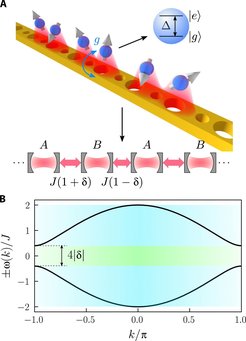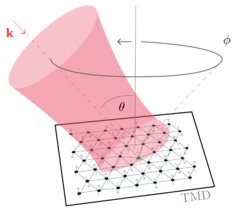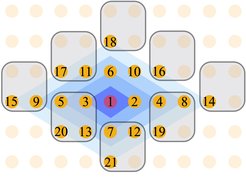Quantum optics
Atoms and light lie at the basis of most of the methods that are used to store, process and transmit quantum information, and the ideas developed in that field are now being implemented in other platforms. Additionally, with the development of new scenarios that combine different technologies, theoretical quantum optics is confronted with new challenges, and the possibility of discovering new phenomena.
Among other, the theory division is carrying out research in different topics, some of them in close collaboration with experimentalists:
Quantum emitters in structured baths

Quantum emitters (natural or artificial atoms, two-level systems, impurities, etc.) interacting with a huge number of degrees of freedom (bath) are a paradigmatic example of an open quantum system, in which many fundamental concepts of Quantum Optics and Condensed Matter Physics can be tested. Traditional approaches have considered simple baths (e.g., with linear dispersion relations) to explain many well-known phenomena, such as photon emission or, in general, Markovian dynamics. Structured baths, on the other hand, offer the possibility to go beyond the standard quantum electrodynamics of atoms in vacuum, and explore the interplay between exotic states of light and matter. Novel effects appear as we consider baths with more complex dispersion relations or with a non-trivial topology: effective dipole-dipole interactions mediated by bound states, directional emission due to coupling to chiral bath modes, bound states in the continuum, just to name a few.

Currently, in the Theory Division, we develop the tools to understand the physics of these more complicated baths, and explore the novel phenomena that originates in baths with a non-trivial Hermitian or non-Hermitian topology, fermionic statistics, etc.
Quantum optics in solid state systems

Solid state systems create unique opportunities for quantum optics but also pose new challenges. In contrast to ultracold atoms and ions, solid state systems are relatively easy to handle as they do not require complex traps. Moreover, many devices with small individual footprints can be fabricated at once, which is a necessary step towards scaling up quantum technologies. A major drawback of solid state systems is, however, the intrinsic complexity of materials. Collective excitations such as phonons and background spins may interact with and may disturb the subsystem of interest such as a single electron in a quantum dot.
The research in the Theory Division aims to apply the toolbox of quantum optics to solid state systems. For example, two-dimensional semiconductors have recently emerged as a promising platform to probe condensed matter phenomena through their strong light-matter interaction. We also aim to accurately model the complex interactions between collective excitations in order to mitigate their adverse effects and to potentially use them to our advantage. In recent work, for instance, we have proposed a method to entangle the spin baths surrounding two distant quantum dots.
Preparation of tensor network states

Matrix Product States (MPS), and more generally, Projected Entangled-Pair States (PEPS), capture the physical properties of systems obeying the entanglement area law. PEPS contains a rich set of many-body states such as the cluster state, toric codes, GHZ state and W state in quantum information, or the AKLT states, valence-bond states, and string-net states in condensed matter physics. There is thus increasing interest in finding ways of preparing them in quantum computers or quantum simulators, either for quantum information applications like computing, metrology, communication and networking, or as variational states for the study of many-body quantum systems.
In the Theory Division, we design general protocols and efficient physical realizations to prepare the tensor network states on matter qubits or photons and explore novel applications based on these state preparation protocols.
Subwavelength atomic arrays

Ordered atomic ensembles have recently attracted attention as a new paradigm for controlling light-matter interaction. When the interatomic separation is subwavelength with respect to the characteristic atomic dipole transition, the optical response of atomic arrays shows a strong collective behavior characterized by bright (superradiant) and dark (subradiant) excitations. Superradiant states allow for efficient coupling of internal atomic states to light, while subradiant states permit long coherent storage of atomic excitations thanks to their reduced linewidth. The array’s collective response gives rise to additional features, like realizing perfect reflection of light off the array and the ability to prepare topological edge modes.
Subwavelength atomic arrays lie at the interface of quantum optics and many body physics, where strong correlations between the atoms leads to genuine quantum phenomena. In the Theory Division, we identify and study these emerging features, and propose ways to leverage them. For instance, exploiting the photonic non-linearity of 1D arrays to implement quantum gates, using a 1D array to replace a photonic crystal in a waveguide QED, or mediating long-range XY interactions between quantum emitters using a 3D atomic bath.




